Emergency lighting and guidance lighting are essential for the safety of building occupants where a sudden loss of light would prevent safe passage from the premises.
EMERGENCY LIGHTING

Our Emergency Lighting Services
Emergency Lighting Maintenance
-
-
Monthly inspections
-
Annual discharge testing
-
Fault Finding and repairs
-
Design and installation
-
In accordance to BAFE Competency Scheme SP203-4 For the Maintenance of Emergency Lighting Systems
BAFE Registered
BAFE SP203-4 Emergency Lighting: Third-party certificated by BSI.
BAFE Fire Safety Register – The trusted independent register of quality fire safety organisations for the UK since 1984
Emergency Lighting Requirements
The Regulatory Reform Fire Safety Order 2005 and British Standard 5266 Part 1: – The code of practice for emergency escape lighting – which provides general guidance on the provision and operation of emergency lighting. Guidance on risk assessments in all types of premises except individual dwelling houses state that emergency lighting is needed in the following circumstances:
- To adequately illuminate designated escape routes
- To provide sufficient illumination in other areas to allow safe movement towards and through escape routes
- To ensure that all fire alarm call points, fire fighting equipment and other safety equipment can be readily located and used
- To provide sufficient light to enable proper shut down procedures to be carried out in dangerous or high risk areas etc.
Types of emergency lighting systems
There are three main kinds of emergency lighting systems;
- Non-maintained – lamp only illuminates in the event of mains failure to the luminaire.
- Maintained – allow the emergency lamp to be operated at any time from the local supply to provide normal lighting but in the event of a power failure to the luminaire, it will illuminate the lamp from its dedicated battery back up power source.
- Combined – multi-lamp luminaires where the emergency lamp can be operated in a non maintained or a maintained mode.
The required operating duration for emergency lighting varies according to the use of the building and can vary from a minimum of one hour to three hours depending on the requirements of the building or the activities taking place within the premises.
Emergency lighting testing
British Standard 5266: Part 8 requires that installed emergency lighting systems shall have continued maintenance and periodic testing carried out, as defined in the standard. In practice, the emergency luminaires must be functionally tested every month and for their full rated duration annually.
The purpose of this periodic testing is to ensure the satisfactory operation of each emergency luminaire, to establish that the light output from each luminaire is sufficient, and ultimately that the system is still fit for purpose and that it corresponds with the requirements of the standards.
For safety reasons, the standards advise that the emergency lighting testing should be carried out at times of least risk to the buildings occupants or if possible, when the premises are unoccupied or in unoccupied portions of those premises.
CASE STUDIES
RELATED NEWS
RELATED CONTENT
RES cover the South of England including the counties of Middlesex, Essex, Kent, East Sussex, West Sussex, Surrey, Hampshire, Dorset, Wiltshire, Gloucestershire, Berkshire, Oxfordshire, Buckinghamshire, Hertfordshire including London, Brighton, Portsmouth, Southampton, Winchester, Bristol, and the surrounding towns of Alton, Aldershot, Andover, Basingstoke, Beaconsfield, Bracknell, Cirencester, Egham, Farnham, Guildford, Henley on Thames, High Wycombe, Maidenhead, Marlow, Newbury, Oxford, Poole, Reading, Slough, St Albans, Staines, Swindon, Watford, Windsor, Woking, Wokingham and Worthing.



;)
;)
